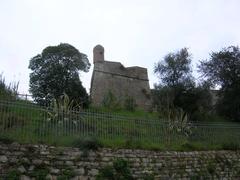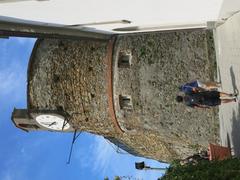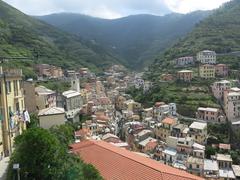Comprehensive Guide to Visiting Porto Venere, Italy
Date: 19/07/2024
Introduction
Porto Venere, a picturesque town on the Ligurian coast of Italy, is a treasure trove of history, culture, and natural beauty. Recognized as a UNESCO World Heritage Site since 1997, the town’s heritage dates back to ancient times, making it a must-visit destination for history enthusiasts and tourists alike (UNESCO World Heritage Centre). Known originally as ‘Portus Veneris’ in honor of Venus, the Roman goddess of love and beauty, Porto Venere has been a strategic maritime base since Roman times. Its rich history is reflected in its well-preserved medieval architecture, including landmarks such as the Doria Castle and the Church of St. Peter (Italy This Way; Lonely Planet). Over the centuries, Porto Venere has captivated the hearts of artists and poets, including Lord Byron and Percy Bysshe Shelley, whose legacies are still celebrated today (Britannica). This comprehensive guide aims to provide you with essential visitor information, including visiting hours, ticket prices, travel tips, and an in-depth look at the town’s historical and cultural significance.
Table of Contents
- Introduction
- Ancient Beginnings
- Roman Era
- Medieval Period
- Renaissance and Baroque Eras
- Napoleonic Era
- Modern Era
- Cultural Significance
- Visitor Tips
- Special Events and Tours
- Conclusion
- FAQ
- References
Exploring the Rich History of Porto Venere
Ancient Beginnings
Porto Venere, located on the Ligurian coast of Italy, has a rich history that dates back to ancient times. The earliest known settlement in the area was established by the Ligurians, an ancient Indo-European people who inhabited the region before the Roman conquest. The strategic location of Porto Venere made it an important site for maritime activities and trade.
Roman Era
During the Roman era, Porto Venere was known as “Portus Veneris,” named after Venus, the Roman goddess of love and beauty. The Romans recognized the strategic importance of the harbor and developed it as a naval base. The town served as a crucial point for maritime routes and military operations. Remnants of Roman architecture and infrastructure can still be found in the area, providing a glimpse into its historical significance (Italy This Way).
Medieval Period
In the medieval period, Porto Venere became a fortified town under the control of the Republic of Genoa. The Genoese recognized the town’s strategic importance and fortified it with walls and towers to protect against pirate attacks and rival maritime republics. The construction of the Doria Castle in the 12th century further strengthened the town’s defenses. The castle, named after the powerful Doria family of Genoa, remains a prominent landmark in Porto Venere (Lonely Planet).
Renaissance and Baroque Eras
The Renaissance and Baroque periods brought significant architectural and cultural developments to Porto Venere. The Church of St. Peter, built in the 13th century, was expanded and renovated during this time. The church, perched on a rocky promontory overlooking the sea, is a stunning example of Gothic and Romanesque architecture. Its distinctive black and white striped facade and panoramic views make it a popular attraction for visitors (Italy Heaven).
Napoleonic Era
The Napoleonic era brought significant changes to Porto Venere. In the early 19th century, the town was occupied by French forces under Napoleon Bonaparte. The French recognized the strategic importance of Porto Venere and used it as a naval base. The town’s fortifications were strengthened, and new military installations were built. The French occupation left a lasting impact on the town’s architecture and infrastructure (History).
Modern Era
In the modern era, Porto Venere has evolved into a popular tourist destination while preserving its historical charm. The town’s picturesque harbor, colorful houses, and medieval architecture attract visitors from around the world. In 1997, Porto Venere, along with the nearby Cinque Terre, was designated a UNESCO World Heritage Site in recognition of its cultural and historical significance (UNESCO World Heritage Centre).
Cultural Significance
Porto Venere’s cultural significance extends beyond its historical landmarks. The town has inspired numerous artists, writers, and poets over the centuries. The English poets Lord Byron and Percy Bysshe Shelley were particularly captivated by the beauty of Porto Venere and its surroundings. Byron’s Grotto, a sea cave named after the poet, is a testament to his admiration for the area. Shelley’s House, where the poet stayed during his visits, is another notable site in Porto Venere (Britannica).
Visitor Tips
For visitors interested in exploring the history of Porto Venere, several key sites should not be missed:
- Doria Castle: This medieval fortress offers panoramic views of the town and the sea. Visitors can explore the castle’s towers, walls, and courtyards while learning about its historical significance. Visiting Hours: 10 AM - 6 PM. Tickets: €10 for adults, €5 for children.
- Church of St. Peter: This iconic church, with its striking architecture and scenic location, is a must-visit. The interior features beautiful frescoes and a serene atmosphere. Visiting Hours: 9 AM - 5 PM. Tickets: Free.
- Byron’s Grotto: Named after the famous poet, this sea cave is accessible by boat and offers a unique perspective of Porto Venere’s coastline. Visiting Hours: 9 AM - 7 PM. Tickets: €15 for boat tours.
- Shelley’s House: Literature enthusiasts will appreciate a visit to the house where Percy Bysshe Shelley stayed. The house is now a museum dedicated to the poet’s life and works. Visiting Hours: 10 AM - 4 PM. Tickets: €8 for adults, €4 for children.
Special Events and Tours
- Guided Tours: Available daily at 11 AM and 2 PM. Booking in advance is recommended.
- Photographic Spots: The harbor, Church of St. Peter, and Byron’s Grotto offer stunning views perfect for photography enthusiasts.
- Special Events: Annual festivals and cultural events are held throughout the year. Check the official Porto Venere website for event schedules.
Conclusion
Porto Venere, with its blend of historical landmarks, stunning natural scenery, and rich cultural heritage, offers an unforgettable experience for visitors. From the ancient Ligurian settlements to its strategic importance during the Roman and Napoleonic eras, the town’s history is deeply embedded in its architecture and landscapes. The medieval fortifications, Renaissance churches, and Baroque influences add layers of depth to its historical narrative (Italy Heaven). Modern Porto Venere continues to enchant visitors with its picturesque harbor, colorful houses, and cultural festivals, ensuring a vibrant and immersive experience (La Spezia Tourism). Whether you’re exploring the Doria Castle, marveling at the Church of St. Peter, or enjoying the serene beauty of Byron’s Grotto, Porto Venere promises a journey through time and a deep connection with Italy’s rich heritage. Plan your visit to this enchanting town and immerse yourself in its captivating history and culture.
FAQ
- What are the must-visit historical sites in Porto Venere? Doria Castle, Church of St. Peter, Byron’s Grotto, and Shelley’s House are the top historical sites to visit.
- What are the ticket prices for Porto Venere attractions? Ticket prices vary: Doria Castle (€10 adults, €5 children), Church of St. Peter (Free), Byron’s Grotto (€15 for boat tours), Shelley’s House (€8 adults, €4 children).
- What are the visiting hours for attractions in Porto Venere? Visiting hours vary: Doria Castle (10 AM - 6 PM), Church of St. Peter (9 AM - 5 PM), Byron’s Grotto (9 AM - 7 PM), Shelley’s House (10 AM - 4 PM).
References
- Italy This Way. (n.d.). Exploring Portovenere. https://www.italythisway.com/places/portovenere.php
- Lonely Planet. (n.d.). Portovenere. https://www.lonelyplanet.com/italy/liguria/portovenere
- Italy Heaven. (n.d.). Portovenere. https://www.italyheaven.co.uk/liguria/portovenere.html
- History. (n.d.). Napoleon Bonaparte. https://www.history.com/topics/france/napoleon
- UNESCO World Heritage Centre. (n.d.). Portovenere, Cinque Terre, and the Islands. https://whc.unesco.org/en/list/826/
- Britannica. (n.d.). Lord Byron. https://www.britannica.com/biography/Lord-Byron-British-poet
- La Spezia Tourism. (n.d.). Portovenere. https://www.turismoprovincia.laspezia.it/en/


